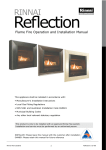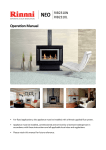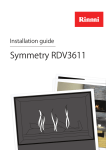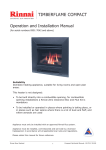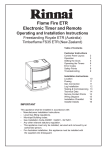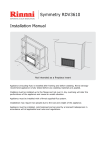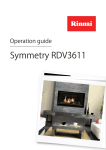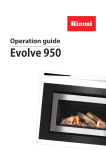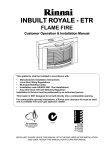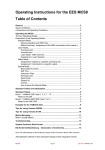Download Rinnai Neo RIB2310N Installation manual
Transcript
NEO RIB2310N RIB2310L Installation Manual Appliance must be installed, commissioned and serviced by a licensed tradesperson in accordance will all applicable local rules and regulations. For installations into a combustible opening, a Rinnai zero clearance box and flue kit are mandatory. Before installation: • Unpack the appliance and components and check for damage—DO NOT install any damaged items • Check all components have been supplied and that you have the correct gas type • Read these instructions to get an overview of the steps required before starting the installation Failure to follow these instructions could cause a malfunction of the appliance. This could result in serious injury and property damage. Contents Checklist 3 Specification 4 Dimensions 5 Location 6 Enclosure dimensions 9 Gas supply 10 Flueing options and components 11 General flueing information 12 Masonry installations 14 Mock chimney installations 16 Freestanding installations 18 Log set installation 20 Granule pack installation 21 Test pressures 22 Checking the flame pattern 24 Fitting the frame assembly 25 Commissioning 26 Wiring diagram 27 WARNING Improper installation, adjustment, alteration, service or maintenance can cause property damage, personal injury or loss of life. For assistance or additional information contact Rinnai on 0800 RINNAI (0800 746 624). Checklist Engine - masonry installation: 1. 2. 3. 4. 5. 6. 7. 8. 9. 10. 1 Rinnai Neo heater (engine) Outer (attached to heater with 2 x 8 g black screws) Glass outer dress guard Inner frame Log set (inside appliance) Packet of burner granules Semi rigid stainless steel gas pipe with 5/8 " UNF flare connection Flared brass adaptor 5/8 " UNF - ½ " BSPT Foam sealing strip Operation and installation manual 2 8 1 4 2 Engine set (see above) Spigot adaptor Spigot guide panel Spigot guide rails Zero clearance box top panel Zero clearance box rear panel Zero clearance box left and right panels Zero clearance box base panel Hardware pack 3 A 5 6 8 7 7 1 Engine set (refer masonry installation) Spigot adaptor Console top panel Console right side panel Console left side panel Console rear panel Console pillar Hardware pack 2 4 A 3 6 8 Engine set (refer masonry installation) Spigot adaptor Plinth top panel Plinth right side panel Plinth left side panel Plinth rear panel Plinth pillar Plinth base Hardware pack 1 5 2 4 3 A 7 5 6 Remote/thermostat - comes with all ETR models 1. RF combination remote/thermostatic control with wall mount 2. AA batteries (x2) 3. Operation manual Rinnai New Zealand Limited 7 6 Freestanding plinth installation: AA 1. 2. 3. 4. 5. 6. 7. 8. 3 5 Freestanding console installation: AA 1. 2. 3. 4. 5. 6. 7. 10 5 Inbuilt mock chimney installation: AA 1. 2. 3. 4. 5. 6. 7. 8. 4 9 3 1 2 3 Neo Installation Manual: 11906-B 02-11 Specification Description • • • • Inbuilt gas space heater Burning log effect Glass front with glass dress guard Convection fan, top air discharge Installation Inbuilt masonry, inbuilt mock chimney, and freestanding options Combustion Method Bunsen type burner Data Plate Inside appliance on the front left hand side Flue - Masonry Rinnai strongly recommends the use of a Rinnai flexiliner flue system (flexi Ø 100 mm). Failure to meet this criteria may result in an unsafe situation. Installation without a flexiliner flue is permissible as long as the chimney is checked for soundness and ability to achieve a good draw. Terminal 240 mm x 45 mm rear discharge (spigot). Flue - Decorative (mock chimney) and Freestanding Natural draft twin skin flue. An approved 100 mm cowl must be fitted to all installations. Decorative chimney installations require a Rinnai zero clearance box and zero clearance flue kit. Flue dimensions: • Outer - 150 mm • Inner - 100 mm Gas Connection ½ " BSPT, the gas supply terminates inside the heater at the front lower right hand side of the appliance Gas Type NG and General Product LPG Convection Fan 2-speed centrifugal, double diameter 160 x 180 mm Heating Area • Up to 107 m2 (NG) • Up to 93 m2 (ULPG) Ignition Continuous spark electronic ignition Input/Output Input NG: 14-30 MJ/h Input ULPG: 14-27 MJ/h Noise Level 37-45 dB(A) Power Consumption High 50 W Standby <3 W 1500 mm cord is supplied with 3-pin plug on the rear left of the appliance Safety Devices Overheat switch, electrical fuse, flame failure sensing system, and power failure protection Temperature Control Output NG: 3.24-6.94 kW Output ULPG: 2.98-6.04 kW Manual models, manual control on unit ETR models, thermostatic, temperature control range 7-32 °C Thermal Efficiency NG - 80.5% ULPG - 80% Efficiency star rating: 4.10 stars Weight 60 kg Rinnai New Zealand Limited 4 Neo Installation Manual: 11906-B 02-11 Dimensions (mm) Inbuilt masonry Inbuilt mock chimney C A B D A F C B F J J E E I G I D H H Freestanding console Freestanding plinth C A D F B C A F B J J E E G I G I H Model D H External dimensions Gas connection A B C D E F G H I J Inbuilt masonry 865 660 359 62 691 589 - 305 45 235 Inbuilt mock chimney 865 660 363 62 795 650 280 305 45 240 Freestanding console 865 760 363 62 865 760 280 305 140 235 Freestanding plinth 865 837 363 62 865 837 280 305 215 235 Rinnai New Zealand Limited 5 Neo Installation Manual: 11906-B 02-11 Location The main points governing location are flueing and warm air distribution. The heater must not be installed where curtains or other combustible materials could come into contact with the appliance. In some cases curtains may need restraining. The Neo gas fireplace is not designed to be built into bookcases. Standard flued appliances draw the air for combustion from the room itself so there is a need for fixed ventilation. Fixed ventilation must be provided as per NZS 5261. Clearances The clearances listed below are minimum clearances unless otherwise stated. Inbuilt models Freestanding models (can be positioned directly on the floor) Rinnai New Zealand Limited 6 Neo Installation Manual: 11906-B 02-11 Location Mantels, surrounds, and hearths for inbuilt installations A mantel and surround are allowed providing they are outside the minimum clearances shown on the previous page. Minimum clearance The minimum clearance from the top of the appliance is 400 mm. The depth of the mantel/ surround at this minimum clearance must not exceed 150 mm. Additional mantel/surround depth For every 50 mm of added mantel depth/surround, there must be an additional 100 mm of clearance. For example; a 200 mm mantel depth will require a 500 mm clearance from the top of the appliance. Hearths A hearth is not necessary but can be used for decorative purposes or protection of sensitive flooring if required. It must not obscure the front of the fire. Electrical connection The Neo is supplied with a power cord (length 1500 mm) and a 3-pin plug. The standard electrical connection passes through the rear panel, but can also pass through the left and right hand side of the unit by removing the knockout tab from the bottom edge of the front panel. If changing the electrical position use the rubber grommet from the rear of the appliance for cable protection. Rinnai recommend the heater is plugged into a dedicated 240 V, 10 A earthed power point. The power point must not be located above the heater (potential fire hazard). If the supplied plug and power cord is to be used with an external power point then the power cord will need to be fitted with the supplied grommet. A suitable means of electric isolation must be provided which is adjacent to the appliance and accessible with the appliance installed. The electrical cord is not fire rated and should not come into contact with the unit. If the supply cord is damaged, it must be replaced by a licensed tradesperson. This must be a genuine replacement part available from Rinnai—part number 6765B. Rinnai New Zealand Limited 7 Neo Installation Manual: 11906-B 02-11 Location TV installation above a fireplace If installing a flat screen TV above the fire the main issue is heat. Heat from the fire and heat from the flueing components that sit behind the TV, especially if recessed. The Neo gas fires have a fan that distributes warm air from the top of the appliance out into the room. As warm air is dispersed outwards as opposed to directly upwards, installation of a TV may be an option. The diagram below outlines recommended minimum clearances when installing a TV directly above the Neo inbuilt models. All dimensions are in millimetres. 75 400 400 Mantel Flue TV TV Flue 20 The 400 mm dimension is the minimum clearance required to combustibles and to a mantel. 200 Rinnai Neo Inbuilt Rinnai Neo Inbuilt For a TV mounted directly above the Neo, the mantel must be at least the depth of the TV to deflect the heat away from the appliance. It is up to the customer to check the TV installation instructions with the TV supplier to verify clearances. Some TV manufacturers have warranty conditions that state a TV is not to be installed above a fireplace. Rinnai does not accept any responsibility for damage to a TV resulting from the use of this information. Rinnai New Zealand Limited 8 Neo Installation Manual: 11906-B 02-11 Enclosure dimensions The enclosure dimensions specified are critical to the successful installation of this appliance. The appliance must be positioned within the enclosure on a flat level surface. If the appliance is to be elevated from the ground, a base must be constructed with supporting joists capable of supporting a minimum of 1.5 times the weight of the appliance. Inbuilt masonry installations Inbuilt mock chimney installations Important The total cavity depth MUST also include the thickness of the external cladding as the zero clearance box MUST BE installed flush with the cladding surface to ensure alignment of the flue. Model Minimum dimensions (mm) Height (H) Width (W) Depth (D) Inbuilt masonry 600 695 370 Inbuilt mock chimney 650 800 370 Rinnai New Zealand Limited 9 Neo Installation Manual: 11906-B 02-11 Gas supply Gas pipe sizing must consider the gas input to this appliance as well as all other gas appliances in the premises. The gas meter and regulator must be specified for the total gas rate. An approved sizing chart such as the one in NZS 5261 should be used. The gas supply termination is inside the heater and enters through the rear of the appliance. Gas supply location 1 Gas supply location Mark off the location for the vertical centre line of the heater enclosure 1 . To the right of the vertical centre line, mark off the vertical 2 and horizontal 3 locations for the gas supply penetration. 2 3 Inbuilt Freestanding Masonry Mock Chimney Console Plinth 2 305 mm to right of appliance centre line 305 mm to right of appliance centre line 265 mm to right of appliance centre line 305 mm to right of appliance centre line 3 45 mm from base of enclosure 45 mm from base of enclosure 140 mm from floor level 219 mm from floor level 4 Terminate 230 mm from Terminate 230 mm from front of enclosure front of enclosure Terminate at wall clearance plus 125 mm Terminate at wall clearance plus 125 mm STEP 1 Freestanding installations TO ON FR The length of the gas supply termination is measured from the front of the enclosure. of ck 4 5 Ba LL WA cle Min ara im nc um e7 5m m OS UR E 4 FE NC L E OF AR RE R E OS U L NC he ate r Inbuilt installations STEP 2 The length of the gas supply termination is measured from the back of the heater plus 125 mm. Installer to terminate to suit, and fit supplied gas connection 5 . Leak test the joint between the flexible gas connection and termination. Gas connection: Gas supply pipe Installer, terminate to suit Rinnai New Zealand Limited Brass adaptor Flexi ½ ” BSPT 10 Neo Installation Manual: 11906-B 02-11 Flueing options and components Inbuilt masonry installations Without flexiliner Inbuilt mock chimney installations With flexiliner A =Direct flue (straight vertical) B = Offset flue Freestanding installations A =Direct flue (straight vertical) B = Offset flue Installation Components available Part no. Description Inbuilt masonry R1756 R1761 RIB2310 flexi flue kit 4 m Flexiliner extension 2 m (extends to 3.6 m) Inbuilt mock chimney, straight vertical flueing R2340 R2345 R1762Z R1763Z R1763SS RIB2310 zero clearance box RIB23 spigot assembly Flue kit galvanised 3.6 m (same as Timberflame Radius) Flue extension 1.2 m galvanised Flue extension 1.2 m stainless steel R1764 R1766 All of the above components, plus: 45 ° bend kit (same as Timberflame) Wall penetration kit galvanised (same as Timberflame Radius) R2345 R1762GL R1763GL RIB23 spigot assembly Freestanding flue kit galvanised black 3.6 m Freestanding flue extension galvanised black 1.2 m R1766GL R1765GL All of the above components plus: Freestanding wall penetration kit galaxy black Freestanding 45 ° bend kit galaxy black Inbuilt mock chimney, vertical offset flueing Freestanding straight vertical flueing Freestanding vertical offset flueing Rinnai New Zealand Limited 11 Neo Installation Manual: 11906-B 02-11 General flueing information Every gas fireplace requires a flue system that will draw effectively and clear flue products safely under all potential wind and climatic conditions. It is the responsibility of the installer to ensure that the appliance is provided with an effective flue. For installations requiring a flue, a Rinnai flue system must be used. The flue system must be fully assembled and secured in place before the appliance is installed. Flashings Flashings to the top of chimney structure do not form part of the flue kit and must be specified. Clearance to combustibles For installations using the Rinnai zero clearance flue components, the minimum clearance from inner flue to combustible material must be greater than 50 mm. This equates to 25 mm from the outer flue when using the Rinnai twin-skin flue. Flue length and number of bends Minimum flue length This is required to ensure adequate draw and prevents spill-back of combustion products which can cause the safety sensors to shut down the unit. • minimum flue length before any bends or offsets • minimum vertical flue length = 1.0 m = 3.6 m Maximum flue length and number of bends Rinnai recommend a maximum flue length of 8 m with a maximum of two 45° bends. Self-supporting flue The weight of the flue system should not be supported by the appliance—it should be self-supporting. Supporting the flue is usually completed during the framing stage with flue supports or straps within the cavity. Rinnai New Zealand Limited 12 Neo Installation Manual: 11906-B 02-11 General flueing information Shared flues Gas appliances must not be connected to a chimney or flue serving a separate fuel burning appliance. Flue cowl clearance To ensure products of combustion are cleared, adequate clearance for the building is required and the below guideline is recommended. Flue cowl should have a 500 mm clearance from any part of the building. This also applies to steeped and pitched roofs which should be clear of the ridge line as shown below. Lesser clearances may provide perfectly adequate flue systems depending on the installation. Minimum clearances are shown in NZS 5261. Rinnai New Zealand Limited 13 Neo Installation Manual: 11906-B 02-11 Masonry installations 1. Check dimensions of the opening Refer 'Enclosure dimensions' and if necessary bring them to the required dimensions. Check the chimney height as inadequate height can effect product performance. Some installations may require the chimney height to be extended to reduce down drafts. 2. Check flueway • Ensure there are no obstructions • Provide a firm, flat and sealed base (sealed means no holes or openings in the fireplace) • Ensure adequate support of the appliance (if not properly supported noise and vibration may result) 3. Install flexiliner flue system To ensure adequate draw for maximum performance of the appliance, Rinnai strongly recommends the use of a Rinnai flexiliner flue system for masonry installations. Failure to meet this installation criteria may result in an unsafe situation. Performance issues resulting from inadequate flueing is not covered by the warranty. Installation without a flexiliner is permissible in masonry installations as long as the chimney has been checked for soundness and ability to achieve a good draw. Masonry installation without aa flexiliner flexiliner flue Inbuilt masonry without Inbuilt masonry with a flexiliner flue Masonry installation with a flexiliner flue Approved chimney cowl Approved chimney cowl Chimney plate Mortar Chimney plate Minimum 200 mm Minimum 3.6 m Mortar Adaptor Minimum 200 mm Minimum 3.6 m Flexible chimney liner Appliance adaptor Rinnai New Zealand Limited 14 Neo Installation Manual: 11906-B 02-11 Masonry installations 4.Installing the heater into the fireplace Apply the supplied foam seal strip to the rear of the heater. The strip is intended to form a seal between the heater and the fireplace. If an adequate seal cannot be formed with this strip another means of sealing must be used (non-combustible insulation) between the fireplace and the heater body. If using a flexiliner flue, prepare the heater engine by drilling four x Ø 3.2 mm holes in the prepressed dimples on the top panel of the heater. Attach the flue guide rails from the flue kit using the supplied screws. Align the guide rails with the guide plate and slide the heater engine into the enclosure until the guide plate is fully against the rear of the front assembly-this will ensure the heater and flue spigot are correctly aligned. Carefully move the appliance into the enclosure ensuring the gas supply feeds into the rear access hole and fasten heater to the fireplace. Guide rails Flue guide rails Guide plate Rear of front assembly Drill 4 x Ø 3.2mm holes Rinnai New Zealand Limited 15 Neo Installation Manual: 11906-B 02-11 Mock chimney installations For installations into a mock chimney a Rinnai zero clearance box and zero clearance flue kit is required to isolate the appliance from combustible materials. Failure to meet this installation criteria will void any product warranty. 1. Construct frame and install zero clearance box Refer 'Enclosure dimensions' and construct frame. Assemble and install the RIB2310 zero clearance box. Installation needs to be on a level base. If this is not done the appliance may twist and become damaged—this will void any product warranty. 650 mm min. The zero clearance box is installed flush with the cladding surface. . in 0 37 m m m 7 800 m m 2. Install the flue and complete electrical connection The weight of the flue system should not be supported by the appliance—it should be selfsupporting. Supporting the flue is usually completed during the framing stage with flue supports or straps within the cavity. Flue supports have been included with the flue kit to assist with this. These are to be riveted to the flue. Please note, a twin-skin flue requires a 25 mm clearance (from the outer flue) from combustibles. Inner flue 100 mm Flue Outer flue 150 mm Combustible Material (must be greater than 50 mm from inner flue) Rinnai New Zealand Limited 16 Neo Installation Manual: 11906-B 02-11 Mock chimney installations Flue cowl 50 mm Clamping spacer Sealing collar (not supplied) Twin-skin flue Outer flue 150 mm Bring the flue down within 50 mm of the unit and then use the slip collar provided in the flue kit. Inner flue 100 mm Any residual heat in the zero clearance box is ducted away via the outer flue 3. Installing the heater into the fireplace Carefully move the appliance into the enclosure ensuring the gas supply feeds into the rear access hole and fasten heater to the fireplace with the four fixings either side of the unit as shown below. Rinnai New Zealand Limited 17 Neo Installation Manual: 11906-B 02-11 Freestanding installations While the following diagrams depict the Neo Freestanding Console model, the steps to constructing the Neo Freestanding Plinth are the same. 1. Attach the flue spigot to the Neo engine Using a 3.3 mm drill bit, drill through the four dimples at the rear of the back panel of the Neo engine. Attach the flue spigot (ordered separately) with the screws provided. Attach flue spigot 2. Assemble, position and secure base assembly to the floor Assemble the base assembly provided in the Neo freestander kit and place on the floor where the Neo is to be located. Using three appropriate bolts or screws secure the base assembly to the floor. This also acts as a seismic constraint. The diagram below shows the base assembly for the Neo Console model. The Neo Plinth base assembly has a pillar section attached. Fixing positi Rinnai New Zealand Limited ons 18 Neo Installation Manual: 11906-B 02-11 Freestanding installations 3. Attach heater to base assembly and fit back panel Lift the Neo freestanding engine into position over the base assembly and fix into position using the four M5 x 10 screws supplied. Remove the three screws from the base of the unit (do not discard) and screw the back freestanding panel into position—nine screws in total. 1 4 2 5 3 6 Three screws from unit base (screws 7,8 & 9) Four screw positions for securing the unit to the base assembly 4. Add top and side panels Install the freestanding top panel using three M5 x 10 and three self tapping screws. Install the freestanding side panels (ensure you push up to minimise the gap) using six screws per side. M5 x 10 screws Self tapping screws Minimise gap Screw positions for side panels Rinnai New Zealand Limited 19 Neo Installation Manual: 11906-B 02-11 Log set installation The granule pack and log set, consisting of five log pieces, comes packaged inside the appliance, you will need to remove the glass retainer (four screws) before installing the granules and log set. Use extreme care when handling the log pieces, they are made from a fragile material and will damage easily. It is important you position the pieces in the order shown below. Incorrect placement can create carbon build up and effect performance. Malfunctioning due to improper log placement is not covered under warranty. The unit must never be used with broken logs and should not be mixed with other burn media (except the Rinnai Neo granules). 1. Check to ensure that the ports of the main burner are clean and clear of any particles and all packaging. 2. Select the thicker ‘Y’ log and fit into position by lining up the two pin holes onto the two pins of the locating bracket that is fixed to the centre of the main burner. 1 3. Select the thick straight log and fit onto the metal locators on the left rear of the panel. When correctly located this log will be touching the burner box walls. 4. Select the thinner ‘Y’ log and fit into position by linking up the two pin holes onto the two pins of the first two logs. Ensure this log is seated all the way down until it touches logs 1 and 2. 2 3 1 1 2 5. Select the longest log and fit onto the metal locators at the right rear of the panel. When correctly located this log will be touching the burner box walls and resting on log 1. 6. Locate the final bowed log onto the metal locater at the base of the right side panel and the bracket fixed to the main burner. Lean the log back until it rests on log 4. 3 4 4 1 Rinnai New Zealand Limited 20 Neo Installation Manual: 11906-B 02-11 Granule pack installation The granules as well as being added to create a more realistic log flame effect (by diffusing the gas flames through the burner ports) also assist in soot prevention and are CRITICAL to the performance of the heater. Never pour the granules directly from the pack as dust particles from the plastic bag may block the ports. NG installations Place the granules evenly across the burner—use the whole pack. ULPG installations Carefully place 30 of the granules as close as possible to the front burner ports as shown on the diagram below. DO NOT cover any of the front right side ports. It’s important this is done correctly as incorrect placement can cause high yellow flames (dirty combustion) that may cause sooting. It is desirable that the flames touch the granules as this diffuses any ‘candling’ effect and enhances the realistic log burning look of the heater. Rinnai New Zealand Limited 21 Neo Installation Manual: 11906-B 02-11 Test pressures To check and set the burner pressures 1. Refer to the data plate located inside the appliance on the front left hand side for the correct gas pressure settings. 2. Using a screw driver loosen the captive Appliance Test Point Pressure Screw (ATPP) and fit the manometer. 3. Remove the dust cap from the regulator adjusting nut and screw. Gas control valve High pressure adjusting nut Gas inlet Low pressure adjusting screw Inlet test point Gas outlet Appliance test point pressure Cap Gas control power connection Rinnai New Zealand Limited 22 Neo Installation Manual: 11906-B 02-11 Test pressures High pressure setting 4. Turn the appliance on and set the heater to its highest setting (refer operation manual). Using a screw driver hold the low pressure adjusting screw stationary while adjusting the high pressure setting nut with a 10 mm spanner. Turning the nut clockwise will increase the outlet pressure while turning the nut anti-clockwise will decrease the outlet pressure. Low pressure setting 5. Disconnect the power to the Gas Control Valve (GCV) by separating the connector for the power supply (yellow wires). The GCV will automatically default to low pressure operation. Using a 10 mm spanner hold the high pressure adjusting nut stationary while adjusting the low pressure screw with a screw driver. Turning the screw clockwise will increase the outlet pressure while turning the screw anti-clockwise will decrease the outlet pressure. 6. Replace the dust cap to its original position. It’s important this is done correctly to ensure the correct operation of the GCV. 7. Reconnect the power to the GCV by rejoining the connector (yellow wires). 8. After confirming the correct pressures, turn the appliance off, remove the manometer, tighten the ATPP sealing screw and leak test. 9. Turn the appliance on and off a few times to check ignition. 10. When you are satisfied that the heater is working correctly, reassemble and start the appliance to check the flame pattern (refer next page). High pressure adjusting nut Increase Low pressure adjusting screw Increase Decrease Appliance test point pressure Decrease Cap POV power connector Rinnai New Zealand Limited 23 Neo Installation Manual: 11906-B 02-11 Checking the flame pattern It may take approximately two hours of operation for the logs to achieve their full flame pattern and glow. During the initial burning in period, some smoke and smell may be experienced. The appliance should be run on the high setting in a well ventilated room until these dissipate. It is important to check the flame pattern during this time. Abnormal flame pattern Abnormal flame performance and/or pattern can indicate a problem with the fire, such as blocked gas injectors, log movement during installation or incorrect flue installation. There are some warning signs that could indicate a problem. • • • • • Unusual smell from the appliance Continued difficulty or delay in establishing a flame Flame appears either very short or very long Flame only burns part way across the burner Severe soot building up on the inside of the glass door Normal flame pattern Abnormal flame pattern Soot build up It is the responsibility of the installer to check that under normal conditions of the appliance, all flue gases are exhausted to the outside atmosphere and that there are no spillage of combustion gases into the room. If the appliance cannot be made to perform correctly, please contact Rinnai. Rinnai New Zealand Limited 24 Neo Installation Manual: 11906-B 02-11 Fitting the frame assembly Before fitting the frame assembly, ensure that it is not scratched or damaged in any way. The frame assembly comes packaged in one box and contains the outer frame, glass dress guard and inner frame. NOTE When placing the assembly down ensure it is placed on its lower edge or flat. If it is placed on its left or right edge the glass may slide out off the stand-off posts. If this should occur ensure that the silicon rubber mounts are not dislodged when sliding the glass back into position. 1. Before installing the frame assembly remove the two black screws that are already positioned in the appliance. These are located on the bottom of the unit, one each side. 2. Take the inner frame and hook the slanted edge (bottom is flat) over the top of the glass retainer brackets and swing down into position onto the magnets. 3. Carefully lift the outer frame assembly complete with glass dress guard, taking care not to tilt it on its edge as the glass may slide out off the stand-off posts. Come in close to the heater and plug in the CAT cable into the control panel. Position of the CAT cable and control panel plug (step 3) CAT cable Control panel plug Rinnai New Zealand Limited 25 Neo Installation Manual: 11906-B 02-11 Fitting the frame assembly 4. Lift and slot the assembly over the top and swing down, the lower screws need to be positioned over and inside the bottom flange. 5. Push the outer frame assembly into position and screw in place with the two screws removed in step 1. Fitting the frame (steps 4 and 5), ensure you do not place excessive tension or pinch the CAT cable CAT cable Position of black screws Fascia assembly Rear view of fascia for reference Commissioning Complete the installation and commissioning checklist in the customer operation manual and make sure you leave the manual with the customer. Explain to the customer about the use and care of the unit and that they understand the instructions. Rinnai New Zealand Limited 26 Neo Installation Manual: 11906-B 02-11 Wiring diagram Rinnai New Zealand Limited 27 Neo Installation Manual: 11906-B 02-11 Address: 105 Pavilion Drive, Mangere, Auckland PO Box 53177, Auckland Airport, Auckland 2150 0800: Phone: 0800 RINNAI (746 624) (09) 257 3800 Fax: (09) 257 3899 Email: [email protected] Website:www.rinnai.co.nz All Rinnai appliances meet or exceed the safety standards required by New Zealand gas and electrical regulations. Rinnai is constantly improving its products and as such information and specifications are subject to change or variation without notice.




























